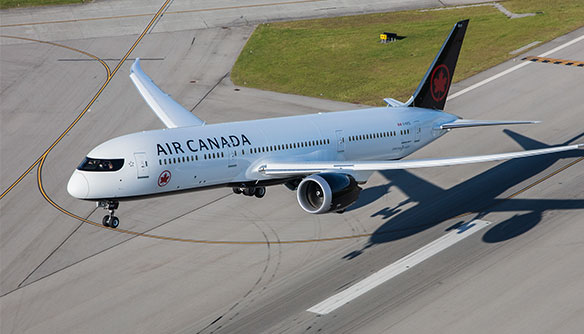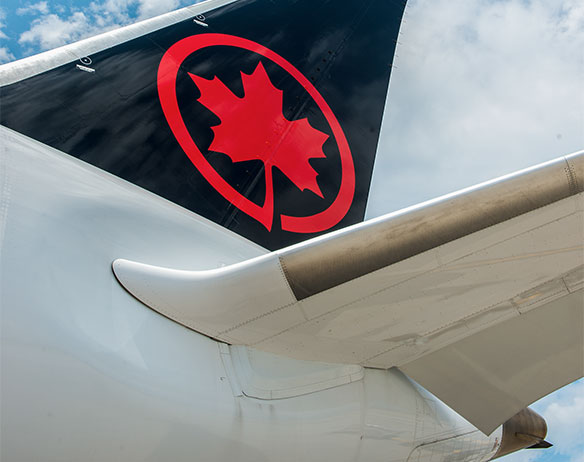
It’s all about choice
Air Canada sets a course to the future with launch of Branded Fares
Bob Mowat
One of the first things that Virgilio Russi will tell you about Air Canada’s launch of Branded Fares is that it’s a “good news story” that’s “going to have a big impact” for Air Canada, for its distribution partners and for their customers.
Canadian Travel Press had a chance to sit down with Russi, senior director, sales – Canada and Duncan Bureau, vice-president, global sales for Air Canada, for a primer on Branded Fares.
What follows is an exclusive question and answer report on that conversation.
Canadian Travel Press: So, tell me about Branded Fares – what are they all about?
Russi: I guess the way you could [describe] it is that with Branded Fares – rather than the traditional model of fares, which simply increase based on availability, on inventory availability – you’re actually bundling different attributes to that fare level [with a Branded Fare] – and today, we have that. We have Tango, Flex and Latitude, which are fare brands and there are several booking classes in all of those.
CTP: Sounds like a good idea. Why didn’t Air Canada introduce Branded Fares sooner?
Russi: Historically, we had more of a Branded Fare structure, which we had to move away from simply because, from a technical perspective, we didn’t have enough letters in the alphabet. Because each fare was attached to a letter. When we started to expand internationally, we had to borrow some letters of the alphabet for more international fares. We had to borrow a couple for the lower business class. We had to borrow two for premium economy. So, we ran out of alphabet letters for Canada.
That has prevented us from really branding fares and having different attributes and price points that are not just related to availability. What we’re going to do now is we will be able – on the same booking class – to have more than one fare –so you can have a Tango fare and a Flex fare – and theoretically, even a Latitude fare – on the same booking class.
CTP: So what’s this mean?
Russi: It means that regardless of the availability, you still have the same, let’s say, G Class open. On that same G Class, you’re going to have a basic fare that is Tango and then for a few dollars more, you’re going to have another fare that includes a free bag. That, perhaps, includes a free change, and then you can start to bundle those attributes. That’s really what [Branded Fares are]. And then you can actually have these different fares on the same booking class – the number of combinations is just multiplied.
CTP: Backing up a bit, does Air Canada have the technology in place to handle Branded Fares now?
Bureau: That has been the biggest investment we’ve had to make in order to accommodate Branded Fares, and we have had a significant team working on this for quite some time now.
CTP: Maybe you can give our readers a little more background?
Bureau: This has been driven by ATPCO and the GDSs’ capability to do this. There has been a huge improvement and ATPCO, in particular, introduced the functionality to be able to showcase the attributes of different fares. This has also been driven by industry, because every airline has had the same issue, because obviously, we’re all dealing with the same alphabet, where you’re handcuffed in terms of how you can file fares.
Russi: The challenge today is that you may have a Fare Brand – for example, Flex – which is different than Tango – and sometimes that’s because it’s the booking class that’s dictating that – so your Flex fare may be $300 more than the Tango fare. And what you’re selling is a free seat [an available seat] and a change fee, so you pay $300 more and save $100. Whereas, if you are able to put them on the same availability, then you can actually price it accordingly. So if [Air Canada is] giving you, with your fare, a package that is worth $100, we’ll probably charge $75 for that.
So, really that’s what it is. On the same availability, we will offer you the option of buying the bare bones product; or we may aggregate seat selection; we may aggregate a meal; we may aggregate other things; and we’ll package it all together and sell that package to you at a discount.
CTP: And Air Canada’s Branded Fares products will be Tango, Flex and Latitude?
Russi: Well, there might be some surprises.
CTP: What are the benefits of Branded Fares for the trade?
Bureau: I believe the biggest benefit to the trade is that you can now do that upsell and be able to explain what the attributes are and what the justification is for – and I’m just making up the numbers – a $30 difference or a $50 difference or a $90 difference, in fare versus historically where you had to jump up an entire fare basis because there was no inventory available at G within Tango – so you had to jump up to Flex, which, potentially, was a $300 fare difference.
CTP: Does that mean that now, with Branded Fares, there won’t be a $300 difference in that category?
Bureau: It depends.
Russi: Simplistically, the difference could be $300 if we’re offering you $350 in terms of added value.
Bureau: It’s going to be directly tied to the attributes that we’re attaching to that – the attribute value between Tango and Flex.
CTP: Obvious question… why are Branded Fares important to Air Canada’s strategy going forward?
Bureau: We want to be able to merchandise and to be able to explain the attributes of all of our different products. So, again, a-seat-is-not-a-seat and we definitely believe that with the types of products that Air Canada has and the network that we have there are different values or attributes of a product that are more meaningful.
Certainly something would be meaningful on a long-haul flight that may not be meaningful on a short-haul flight. So whether that’s seat choice – if it’s an hour’s flight, people are generally less concerned about where they’re sitting, but if it’s a 15-hour flight, people are definitely concerned about where they’re sitting. If they’re travelling alone or if they’re travelling with their family, different things are important to them.
And so our ability to be able to package and create value for the consumer – based on what’s important to them on that trip – is something that we believe will significantly improve the overall experience. It also allows travel agents to be able to increase their revenue by selling attributes and value that they couldn’t [sell] historically.
Russi: One of the things that we always hear from travel agents is about ancillaries and how can Air Canada help them sell [ancillaries] and pay commission on those sales. One of the challenges that we’ve had is just to be able to track those ancillaries when they’re sold separately. Now, if you’re selling a combo with all these ancillaries, then it’s something we can work together [on] much more effectively. And for the travel agents, it’s one transaction. It’s not selling the fare and then asking: Would you like fries with that? It’s a package.
Bureau: It’s a bundled fare. It’s a bundled package, with attributes, that has a price associated with it.
CTP: How will Branded Fares help differentiate Air Canada from its competitors?
Bureau: Well, first of all, there are other carriers who are moving toward Branded Fares today. And again, this was driven off the capability of ATPCO and the GDSs to be able to support this type of pricing model. For Air Canada, it’s about giving the consumer more choice and giving them the opportunity to purchase attributes that are important to them, and doing it in a way that we could distribute through our distribution partners and be able to articulate to our distribution partners what that value is.
Clearly, we’re not the only airline headed in this direction. Our competitors are headed in that direction, and we want to be ready when the market goes that way – and it will.
Watch & learn
Air Canada has also developed a webinar on Branded Fares for travel agents and all agents need do is go to the links below to watch them:
https://www.screencast.com/t/g3RUPhCUR (English)
https://www.screencast.com/t/IphHU5AtF (French)
All about definitions
If you go to the Airline Tariff Publishing Company’s website, you will find the following definition of Branded Fares:
“Branded Fares are defined as airline fares organized into commercially recognizable products with distinct service offerings associated to the brand. Normally, multiple brands are available and are related to price and service tiers or levels.”
(http://training.atpco.net/fmhelp/WebHelp/mergedProjects/Branded%20Fares/What_are_Branded_Fares.htm)



